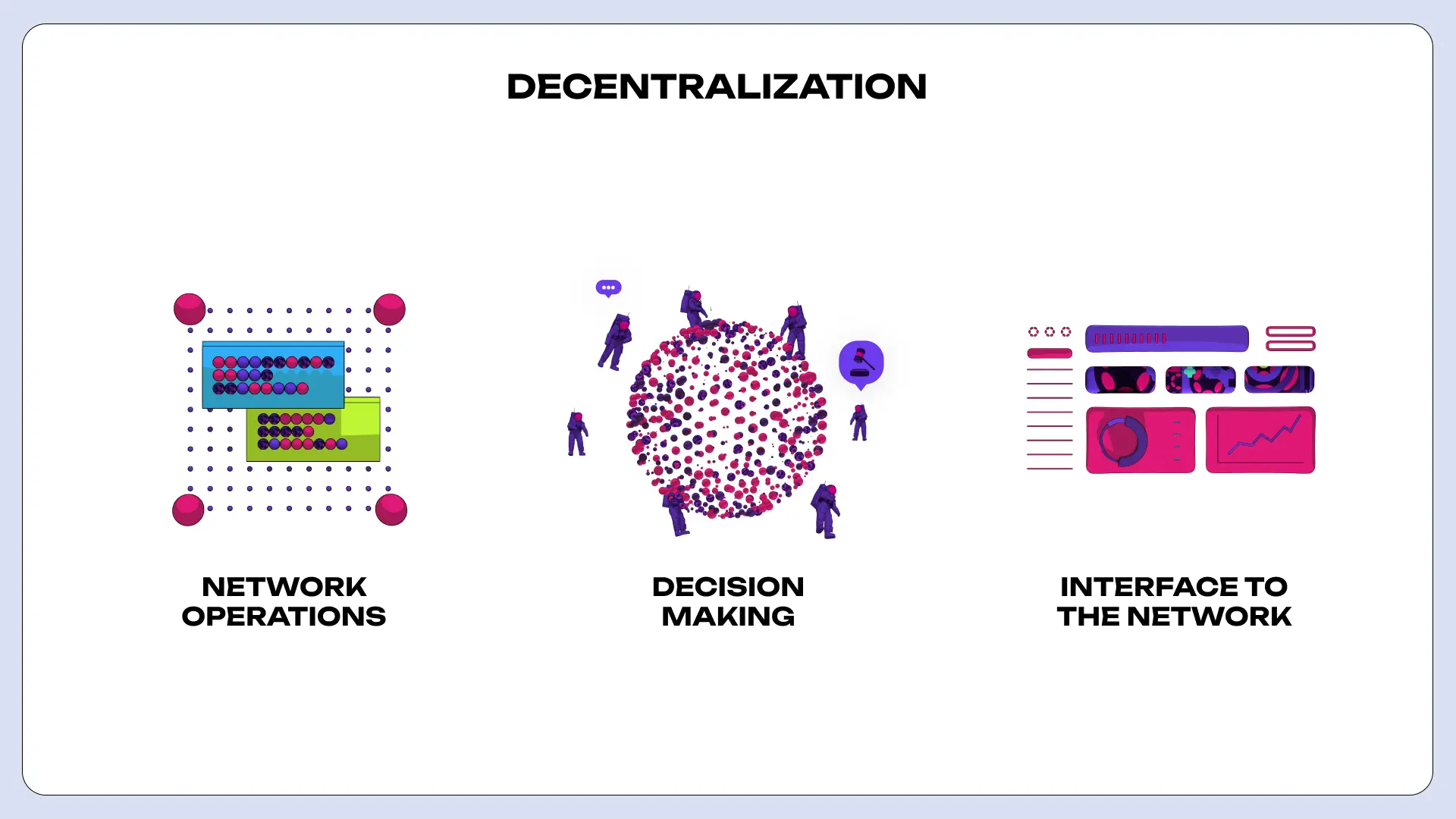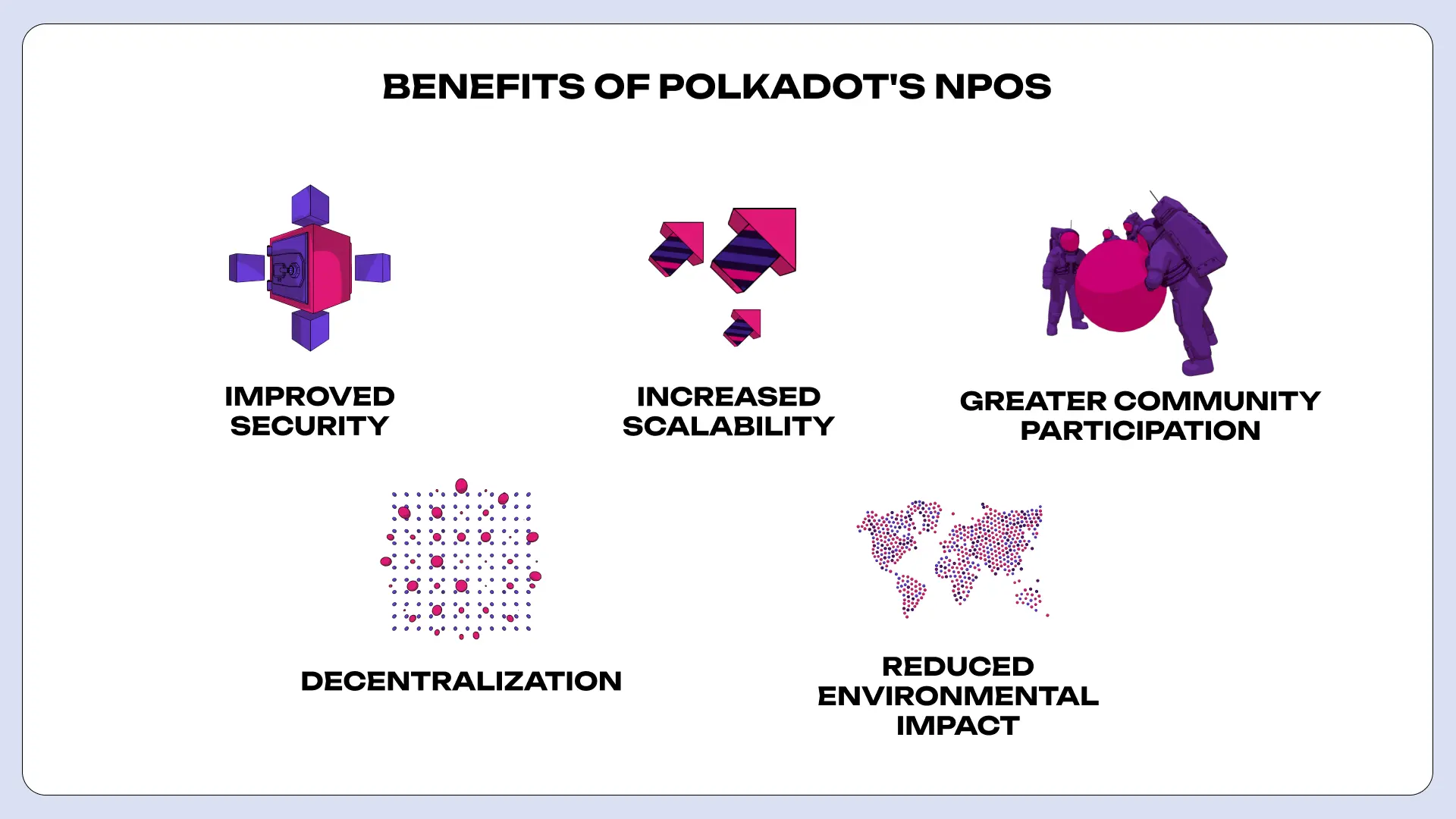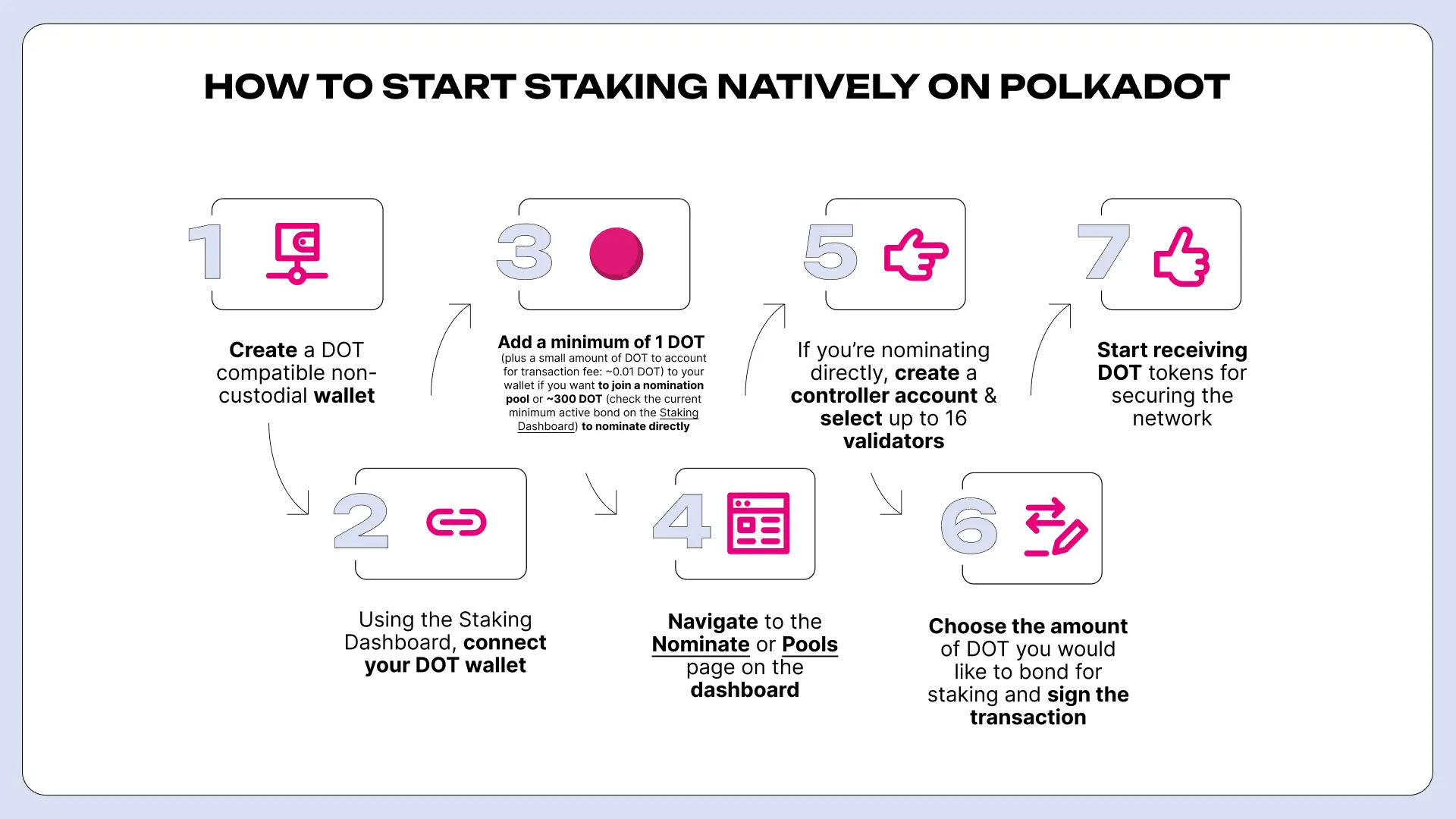Polkadot Consensus Part 1: Enhanced Economic Security via NPoS
The first installment in the NPoS series describes how Polkadot maintains a more secure, open and more decentralized network due to its novel consensus system, NPoS.

The Web3 landscape's most robust and vibrant ecosystems are those that embody true decentralization. In this trustless environment, power is distributed among multiple participants, eliminating any single point of vulnerability. These qualities make blockchain networks more resilient and secure to security threats and malicious activities, which is essential for creating long-term viability and success for projects built on them.
The Polkadot ecosystem thrives within this environment, thanks to its novel design elements, including its patented NPoS (Nominated Proof of Stake) system.
Consensus mechanisms are one of the most essential components of a decentralized network. These mechanisms help streamline decision-making and enhance the blockchain network's overall dependability. Their main job is to ensure that everyone in a network agrees on various topics, from block creation to incentive structures and more. In the context of blockchain networks, they are essential for carefully confirming and validating transactions, which safeguards the network's security, reliability, and immutability. There are many varieties of consensus systems based on Proof of Work (PoW) or Proof of Stake (PoS) algorithms.
PoS requires that network participants stake their tokens as a means of supporting blockchain operations. Its original goal was to provide an alternative to PoW, which is energy-intensive, inefficient when it comes to fees, and limited in its scalability. By providing the same level of security at lower rates and with a much higher bandwidth, PoS aims to improve on these aspects. While Ethereum and other blockchains have been slowly transitioning to PoS, Polkadot already launched with PoS consensus, and later evolved to its patented NPoS system, which has many advantages over PoS.
The first installment in the NPoS series describes how Polkadot maintains a more secure, open and more decentralized network due to its novel consensus system, NPoS. In addition, we examine the design elements that facilitate community participation in terms of Polkadot staking, and the importance of inclusivity to the long-term success of blockspace ecosystems.
The case for decentralization
In contrast to centralized systems controlled by a single entity, blockchains are distributed networks. Because they do not have a single point of failure, they are more secure and reliable for storing sensitive data or executing transactions safely.
In their operations, blockchains produce blockspace, the essential resource for Web3 applications. High-quality blockspace should be scalable, cost-effective, and secure. All three aspects are affected by the consensus system chosen for a blockchain.
Polkadot's approach to achieving decentralization
Recognizing that full decentralization is critical for creating a safe, resilient, and inclusive blockspace ecosystem Polkadot has advocated for more decentralization in Web3 since drafting the Polkadot Whitepaper.

Through deliberate and sophisticated design decisions, Polkadot addresses decentralization in three key areas:
1.Network operations via staking
Through Polkadot's staking model, users can secure and validate transactions with their DOT tokens. It comprises two main actors: nominators and validators.
Nominators
Polkadot ecosystem nominators are relatively passive participants, which means they contribute to network health and security indirectly. Nominators have two tasks to accomplish: selecting a responsible validator and adding tokens to the voting pool. As a result of appointing their stake, they can elect validators and share the rewards.
Participating as a Polkadot nominator is straightforward via the Staking Dashboard.
Although nominators are not required to run their own nodes or worry about online uptime, they are expected to do their due diligence on the validators they select. In addition, when nominating validators, nominators should pay attention to their reward percentage and risk losing out if their validator gets slashed.
Validators
A validator is a staking provider, and is an active member of the network. They distribute rewards among the nominees, who in turn, benefit from digital assets by voting for their chosen validator. Not only is it valuable to increase the number of validators but also enabling and increasing the number of nominators that "vote" on the validators without having to run the whole infrastructure. This is a great advantage of PoS consensus such as Polkadot NPoS that features nominators.
Polkadot takes proactive measures to foster a decentralized network that's well-equipped to fend off potential threats by inviting a broader spectrum of stakeholders to partake as validators. Through NPoS, individuals from diverse backgrounds are able to engage actively in staking, far more so than with typical PoS networks such as Ethereum which does not feature nominators. The deliberate inclusivity of Polkadot’s NPoS curtails the danger of centralization and elevates the resilience of the validator network.
Nomination pools have recently been added to Polkadot’s staking system to increase participation. These pools allow users with smaller stakes to nominate and earn rewards by pooling their tokens and delegating them to validators. By applying this elegant solution, participation is democratized, fostering a decentralized, equitable ecosystem while leveling the playing field.
Learn more about Polkadot stalking in this Wiki guide.
2. Decision making via open governance
All DOT token holders can actively participate in decision-making on behalf of how the Polkadot network is run via the unique governance model Polkadot OpenGov. The community can propose network upgrades, parameter adjustments, and policy changes through referenda. Rather than being controlled by a centralized authority, this open and transparent governance approach allows decisions to be made collectively, reflecting the interests of the community.
3. User interaction with Polkadot via a decentralized light client
Polkadot’s Substrate Connect trustless light client allows users to interact with multiple blockchains without relying on a central authority to access information. Users are empowered to take full control of their interactions with the blockchain network by facilitating decentralized access.
The absence of light clients can be problematic even in highly decentralized networks. As a result, users often rely on centralized service providers, which leads to frequent failures and disruptions. Providing users with light clients will ensure smoother and more reliable interactions with the decentralized network.
Polkadot consensus: building a decentralized and secure future
From the early days of Polkadot’s conception, the founders recognized the importance of decentralization and inclusivity. PoW systems of the past were both exclusive and energy-intensive, favoring those with extensive computing power. In search of a more environmentally friendly and accessible alternative, Polkadot employed a PoS consensus system from the time it launched (until NPoS was constructed to improve on PoS).
Depending on the volume of tokens a validator stakes, they have a higher chance of being selected as a validator in a PoS system. While this provides a more energy-efficient and eco-friendly method of securing the network, it also creates a potential centralization problem.
In PoS, power and influence could be concentrated among a select few with substantial token holdings. The decision-making and governance processes of a network could be dominated by a small group of validators when they control the majority of its resources. This concentration of power contradicts the core values of blockchain, namely decentralization, transparency, and inclusivity.
The degree to which a blockchain is deemed decentralized is determined by the number of independent nodes or entities participating in its adopted consensus. Within PoS consensus, the metric to determine the number of contributors to consensus is called the validator count.
There is generally a correlation between a higher validator count and greater decentralization because having more validator participation reduces the control and influence that any single entity can exert over network decisions. However, after the Ethereum Merge, the importance of the validator count as the sole metric for decentralization has diminished. The degree of a network's decentralization and security should rather be determined by additional factors such as:
- Stake distribution
- Collusion resistance
- Diversity of clients
- Active participation
- Geographic diversity of validators
Therefore, to assess Ethereum 2.0 and similar PoS blockchains, it becomes crucial to take into account these aspects.
How NPoS supports decentralization
NPoS implements incentives that drive the network toward greater decentralization when factors such as the number of validators and the diversity of entities operating them are kept constant. In combination with features that enhanced the validator landscape, NPoS contributes to heightened decentralization compared to other PoS networks.
NPoS boasts two key attributes that substantially bolster decentralization:
1.Flexible nominator choices
Nominators can select, or nominate multiple validators (up to 16 validators in Polkadot and up to 24 validators in Kusama). As long as at least one of the validators nominated is chosen, the election mechanism ensures that the entire stake contributed by nominators is utilized. This unique feature significantly enhances decentralization and economic security within NPoS, setting it apart from other PoS systems.
The inclusion of nominators within NPoS yields notable benefits because it boosts validator stake: nominators' participation bolsters the stake supporting validators, consequently enhancing the network's economic security. It also lowers the barriers to entry for users with smaller DOT holdings to participate in staking.
2. Empowering emerging validators
Validators in NPoS have the advantage that validators who are bootstrapping can be funded without risk by nominators. Nominators are fully rewarded even if only one nominated validator is selected (possibly a well-funded and robust one), as the entire stake contributes to network security and by backing promising new validators that they deem to be behaving well, nominators can take calculated risks. While aligning incentives to maximize rewards, regardless of selection outcomes, this approach fosters decentralization without compromising economic security.
In typical PoS systems, unselected stakes remain inactive, which results in capital inefficiency.
The benefits of Polkadot NPoS
By adopting NPoS, Polkadot gained several key advantages. Along with improving security, NPoS encourages greater community involvement, thereby increasing the network's resilience. Token holders from diverse backgrounds can actively contribute to strengthening the economic security of the network (with few limitations) and get rewarded for participating in governance and validation (staking). Not only does this level the playing field for blockchain participants, it also promotes decentralization of power within the blockspace ecosystem. By allowing token holders to nominate validators, NPoS can also enhance the transaction processing capacity of a network and facilitate smoother operations.

Design decisions and goals of NPoS
Polkadot's patented NPoS is the result of meticulous design decisions geared towards creating a secure, decentralized network. This is achieved through a set of innovative mechanisms:
Economic security and resilience
- Election algorithm
Unlike PoS, economic security within NPoS is also driven by the fact that nominators can use their funds without the know-how and resources required to become a validator. An election algorithm (described in more detail later) determines the best validator candidates which maximizes economic security.
With NPoS, the number of tokens supporting validators is increased compared to PoS, which has boosted the economic security of the Polkadot ecosystem. A substantial increase has also been made to the minimum stake, so even the least supported validator receives more support. - Slashing mechanism
Just like PoS, NPoS also implements a slashing mechanism. When a validator engages in malicious behavior or violates the system, a portion of their staked tokens can be lost. The alignment of incentives through stake increases the likelihood of robust slashing and increases the economic consequences of bad behavior, thereby making the ecosystem more secure.
Accessibility and decentralization
- Participation
DOT holders can nominate validators from 450.994 DOT at the time of writing and select on the basis of whether they are trusted to secure the network. The addition of easy and accessible nominations within NPoS made participation in the staking process far easier, and that was before nomination pools launched.
The launch of nomination pools on Nov 1, 2002 significantly stimulated active accounts. In 2023, the number of pools has more than doubled, and the number of pool members has more than tripled. This has resulted in Polkadot being more economically secure, as NPoS has created a more inclusive ecosystem.
Consider a situation where 100M nominators are backing 100 validators. If the same 100 validators were controlled by two entities (for example, Amazon and Google), they would effectively control the network, and the blockchain would therefore not be decentralized.
In the validator selection process, stake-based factors are combined in order to increase decentralization and economic security, ensuring a diverse and decentralized network. Validators are chosen based on the number of nominations they receive and their staked DOT tokens. The active validator set is regularly updated to encourage competition and to enable new validators to participate, fostering an open and inclusive ecosystem where stakeholders can voice their concerns. - Nomination pools
Staking and network participation are more accessible to a broader audience using nomination pools. To not introduce an element of centralization, it is important that nomination pools are native. Nomination pools on Polkadot empower individuals who might otherwise be excluded from the staking process by allowing them to pool their resources, share rewards, and contribute to network security together with as little as 1 DOT. As a result of this inclusive approach, blockchain networks can be both decentralized and accessible.
Explore how to stake on Polkadot
The role of stake distribution
Implementing NPoS brought significant changes to stake distribution, which further enhanced economic security and fairness.
Stake distribution
Stake distribution in Polkadot aligns validators and nominators interests network stability to ensure economic security. Distributing nominator's staked tokens among validators mitigates centralization risks, discourages collusion, and promotes ecosystem resilience.
As a result of this equitable engagement, honest network participation is encouraged and malicious behavior is safeguarded, thereby enhancing network security. According to this system, prospective validators express their desire to become candidates for validation, and these candidacies are transparently shared with all nominators. Nominators can compile a roster of up to 16 preferred candidates, and their stakes are systematically allocated between validators in a balanced manner to ensure economic security.
NPoS helps distribute stake to validators who may otherwise be excluded from participation, which further boosts the decentralization and economic security of the Polkadot ecosystem. In NPoS, nominators also earn more rewards when supporting validators with a smaller total stake behind them. This incentivizes nominators to choose validators with lower total stake, further contributing to the even distribution of stake across the potential validator set.
The Phrágmen election algorithm
Validators are selected in a more fair and more secure manner thanks to a reworked election algorithm based on a sequential Phragmén method introduced by Edvard Phragmén in the 1890s. The Phrágmen election is a multi-winner election algorithm that combines off-chain computations with on-chain verification to ensure accuracy.
Security, scalability, and community participation have improved since the adoption of NPoS. The validator set has been constantly expanding since launch to further improve security and resilience. More improvements are currently being explored including an improved election algorithm and the possibility of staking on a dedicated system parachain, paving the way for more advanced and robust staking.
Contribute to the decentralized future: start staking with Polkadot
The aim of Polkadot is to create a blockspace ecosystem that is truly decentralized and transformative, capable of navigating the challenges facing Web3. As a validator or nominator, you can contribute directly to consensus, and join the decentralized revolution today by staking your DOT tokens.
How to start staking natively on Polkadot

Editor(s): Isobel Weston
Contributor(s): Gonçalo Pestana, Natalie Tillack












